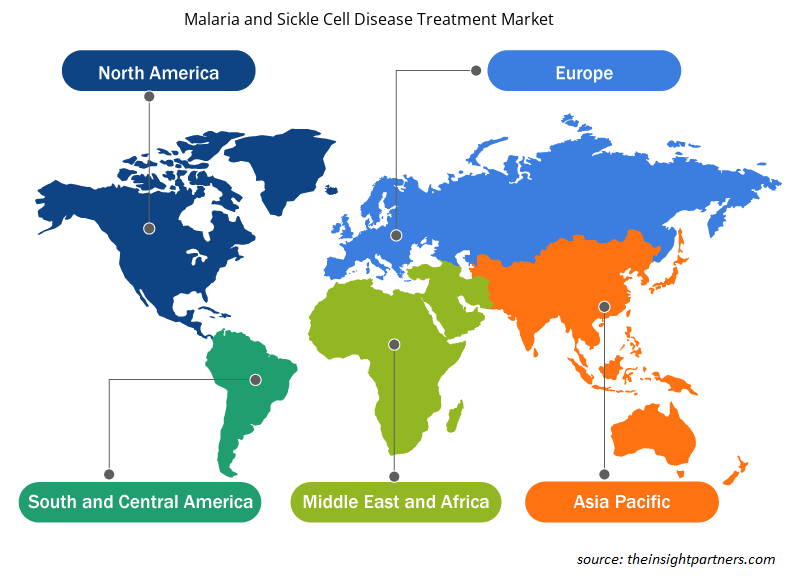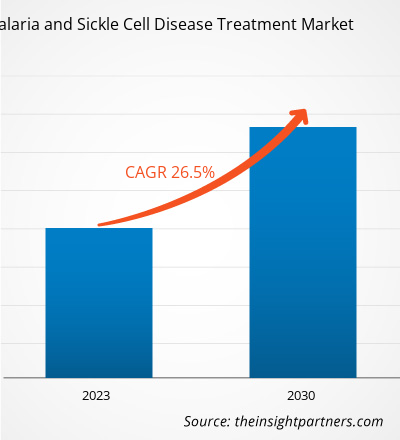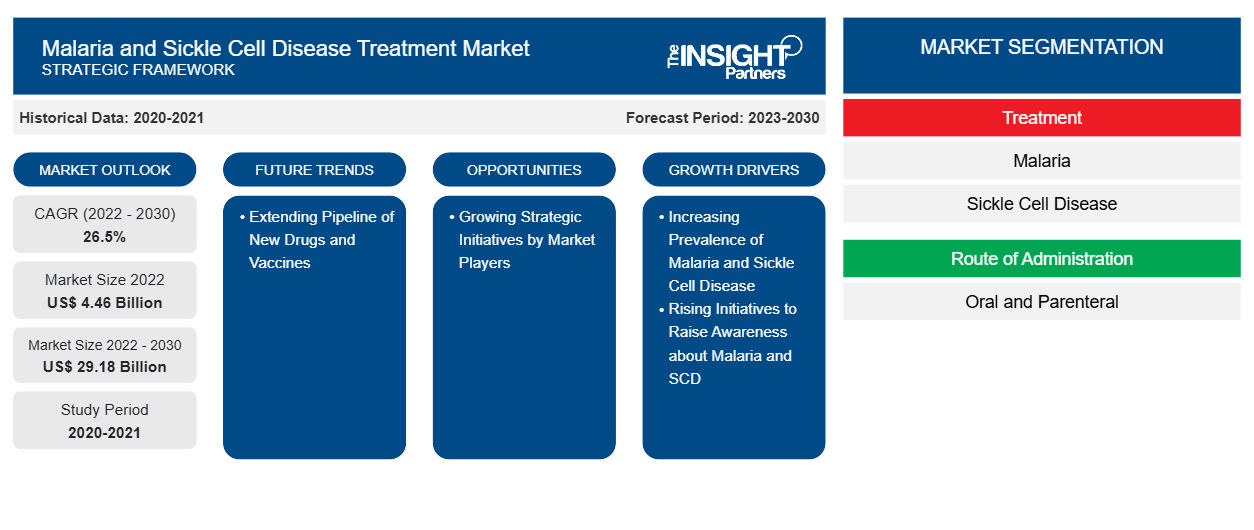[研究报告] 2022年疟疾和镰状细胞病治疗市场规模价值为 44.5715 亿美元,预计到 2030 年将达到 291.796 亿美元;预计 2022 年至 2030 年的复合年增长率为 26.5%。
市场洞察和分析师观点:
疟原虫属的一种寄生虫会导致疟疾,这是一种可能致命的疾病。雌性按蚊叮咬会传播这种寄生虫。东南亚、中美洲和南美洲以及撒哈拉以南非洲的一些地区也存在这种寄生虫,这些地区是疟疾最容易发生的地区。虽然有五种疟原虫可以感染人类,但恶性疟原虫 (P. falciparum) 和间日疟原虫 (P. vivax) 是最常见的疟疾病因。某些红细胞异常会随着时间的推移而发生变化,从而减轻疟疾的严重程度。镰状细胞性状就是其中一种红细胞疾病,患者会产生正常和异常的血红蛋白。
增长动力:
疟疾是一种急性发热性疾病,由疟原虫引起,通过受感染的雌性按蚊传播。人类主要有五种寄生虫导致疟疾,其中两种——恶性疟原虫和间日疟原虫——被认为是对人类健康的最大威胁。此外,恶性疟原虫是最致命的疟疾寄生虫,在非洲大陆传播最为广泛。此外,间日疟原虫是撒哈拉以南非洲以外大多数国家的主要疟疾寄生虫。根据世界卫生组织 (WHO) 最新的《2020 年世界疟疾报告》(WMR),全球报告了 2.41 亿例疟疾病例,而 2019 年记录的病例为 2.27 亿例。根据同一来源,疟疾造成的死亡人数每年增加 69,000 人。其中约三分之二(即 47,000 人)的死亡是由于 COVID-19 疫情期间医疗服务中断造成的;其余三分之一(即 22,000 人)的死亡反映了世卫组织最近计算疟疾死亡率的方法的变化(与 COVID-19 疫情中断无关)。
世卫组织非洲区域占全球疟疾负担的很大一部分。2020 年,全球约 95% 的疟疾病例和约 96% 的疟疾死亡发生在非洲,报告的死亡总数中约 80% 是 5 岁及以下儿童。据世卫组织称,尼日利亚、坦桑尼亚、刚果民主共和国和莫桑比克四个非洲国家记录了全球约一半的疟疾相关死亡病例。根据《柳叶刀区域卫生 2020》报告,非洲国家的疟疾负担最重;恶性疟原虫是 5 岁以下儿童死亡率最高的主要原因,占全球约 77%;在非洲国家,恶性疟原虫占疟疾导致儿童死亡总数的约 96%。间日疟原虫是疟疾病例总数的 2%(450 万)的病原体,主要来自亚洲。根据 WMR 2021,东南亚国家记录了全球疟疾负担的约 2%,其中印度占 2020 年估计疟疾病例的 83% 和疟疾相关死亡人数的 82%。
镰状细胞病(SCD)的治疗方案可分为维持健康和治疗并发症两大类。镰状细胞性贫血具有基于血红蛋白基因独特突变的基因型和表型变异。该病在全球的发病率很高,严重程度也呈上升趋势。根据世界卫生组织的数据,全球约有5%的人口具有抑制镰状细胞性贫血和地中海贫血等血红蛋白疾病的基因。根据美国国家医学图书馆发表的一项关于镰状细胞病的研究,每年有超过30万名婴儿出生时患有严重的血红蛋白疾病;此外,预计到2050年将有40万名新生儿患有镰状细胞病。此外,根据美国血液学会2023年发表的报告,美国患有SCD的人数估计约为7万至10万人。因此,全球不同地区疟疾和镰状细胞病患病率的上升推动了疟疾和镰状细胞病治疗市场的增长。
定制此报告以满足您的需求
您可以免费定制任何报告,包括本报告的部分内容、国家级分析、Excel 数据包,以及为初创企业和大学提供优惠和折扣
-
获取此报告的关键市场趋势。这个免费样品将包括数据分析,从市场趋势到估计和预测。
报告细分和范围:
疟疾和镰状细胞病治疗市场根据治疗、给药途径、分销渠道和地理位置进行细分。根据治疗,市场分为疟疾和镰状细胞病。根据给药途径,疟疾和镰状细胞病治疗市场分为口服和肠外给药。根据分销渠道,市场分为直接招标、医院药房、零售药房、网上药房和其他。根据地理位置,疟疾和镰状细胞病治疗市场分为北美(美国、加拿大和墨西哥)、欧洲(德国、法国、意大利、英国、西班牙和欧洲其他地区)、亚太地区(澳大利亚、中国、日本、印度、韩国和亚太其他地区)、中东和非洲(阿联酋、沙特阿拉伯、非洲、尼日利亚、刚果、坦桑尼亚、乌干达、加纳、肯尼亚、赞比亚和中东和非洲其他地区)以及南美洲和中美洲(巴西、阿根廷和南美洲和中美洲其他地区)。
节段分析:
疟疾和镰状细胞病治疗市场按治疗方式分为疟疾和镰状细胞病。2022 年,疟疾细分市场占有较大的市场份额,预计 2022 年至 2030 年,同一细分市场的复合年增长率将达到 28.5%。疟疾主要由恶性疟原虫引起。疟疾不能直接在人与人之间传播;只有被感染的蚊子叮咬才能传播进入血液并传播到肝脏的寄生虫。氯喹(也称为磷酸氯喹)是一种抗疟药,在美国仅可通过处方获得,并以 Aralen 品牌出售,它也是一种仿制药。奎宁于 1820 年从金鸡纳树皮中分离出来,是第一种发现的抗疟药。世卫组织建议使用 RTS、S/AS01(RTS、S)疟疾疫苗来预防儿童疟疾。加纳、肯尼亚和马拉维正在进行的试点项目的结果为首剂疟疾疫苗的推荐提供了依据。试点四年后,自 2019 年以来,约有 150 万名儿童接种了第一剂疟疾疫苗。
根据给药途径,疟疾和镰状细胞病治疗市场分为口服和肠外给药。2022 年,口服部分占据了更大的市场份额,肠外部分预计在预测期内将录得更快的复合年增长率。口服给药是最理想和最合适的给药途径,因为它具有高患者依从性、非侵入性、最少的无菌限制、成本效益、剂型设计的灵活性以及制造过程的简易性。易于给药和长期成本效益等优势是推动口服药物采用的主要因素。胶囊、片剂和其他口服药物的低制造成本推动了疟疾和镰状细胞病治疗市场的增长。一些可用的抗疟疾药物是奎宁、奎尼丁、氯喹、阿莫地喹、他非诺喹氯胍、氯丙胍和青蒿素。青蒿素类联合疗法(ACT)和联合疗法用于治疗恶性疟原虫引起的无并发症疟疾。ACT 是目前市场上最有效的抗疟药物。
根据分销渠道,疟疾和镰状细胞病治疗市场细分为直接招标、医院药房、零售药房、在线药房等。直接招标部分在 2022 年占据了最大的市场份额。招标是执行特定任务或以固定金额提供物品的要约。在招标程序的第一步中,将要求承包商提交密封的施工投标或在特定期限内提供特别计划的服务或产品。印度的电子招标程序旨在确保及时完成政府或特定客户的工作。例如,有些地方可能有特定的采购法规,规定如何做出决策以及接受哪些投标。例如,全印度医学科学研究所 (AIIMS) 邀请经验丰富、声誉卓著且财务状况良好的公司、机构和企业竞标来自印度不同医疗机构的疟疾检测试剂盒和药物。那些在过去三年内从事类似业务并向中央/州政府/知名私立医院或自治机构提供相同服务的人可以用密封的信封寄送他们的技术和商业投标。
区域分析:
根据地理位置,疟疾和镰状细胞病治疗市场分为五个主要区域——北美、欧洲、亚太地区、南美和中美以及中东和非洲。2022 年,北美占据了全球市场的很大份额。根据美国疾病控制和预防中心 (CDC) 的数据,美国每年报告约 2,000 例疟疾病例,其中大部分是来自其他国家的旅行者和移民。孕妇和 5 岁以下儿童感染疟疾和发展为严重疾病的风险最高。由于能够在美国传播疟疾的按蚊(媒介)的持久性,美国存在疟疾传播可能恢复的永久风险。
根据全球基金 2022 年 4 月的数据,疟疾相关病例和死亡人数增加主要是由于资金延迟和 COVID-19 大流行造成的中断。然而,正如全球基金 2022 年 9 月报告中提到的那样,缓解这些影响的努力已经取得了进展。美国政府为控制疟疾所做的努力主要包括通过美国总统疟疾倡议 (PMI) 开展的活动,该倡议由美国全球疟疾协调员监督。根据全球卫生政策,美国在 2022 财年为疟疾控制和研究活动提供的资金约为 10 亿美元。美国政府在 PMI 战略 2021-2026 下的目标是努力减少疟疾造成的死亡并降低疟疾发病率,从而接近其消除疟疾的长期目标。
在美国,大量非裔美国人患有镰状细胞病。自 2006 年以来,美国所有州都要求新生儿通过血液检测进行镰状细胞病筛查。根据美国疾病控制与预防中心的研究“在 COVID-19 大流行期间,镰状细胞病相关死亡率似乎更高”,2014-2019 年期间,美国镰状细胞病相关死亡率保持稳定;但该国在 2020 年记录了 1,023 例镰状细胞病相关死亡病例,与 2014-2019 年的死亡率相比激增了 12%。根据美国血液学会 2023 年发布的数据,约有 70,000-100,000 名美国人患有镰状细胞病,这是一种最常见的遗传性血液疾病。因此,美国疟疾和镰状细胞病治疗市场的增长是由疟疾和镰状细胞病患者数量的增加推动的。
疟疾和镰状细胞病治疗市场区域洞察
Insight Partners 的分析师已详尽解释了预测期内影响疟疾和镰状细胞病治疗市场的区域趋势和因素。本节还讨论了北美、欧洲、亚太地区、中东和非洲以及南美洲和中美洲的疟疾和镰状细胞病治疗市场细分和地理位置。

- 获取疟疾和镰状细胞病治疗市场的区域特定数据
疟疾和镰状细胞病治疗市场报告范围
| 报告属性 | 细节 |
|---|---|
| 2022 年市场规模 | 44.6亿美元 |
| 2030 年市场规模 | 291.8亿美元 |
| 全球复合年增长率(2022 - 2030 年)CAGR (2022 - 2030) | 26.5% |
| 史料 | 2020-2021 |
| 预测期 | 2023-2030 |
| 涵盖的领域 |
按治疗
|
| 覆盖地区和国家 |
北美
|
| 市场领导者和主要公司简介 |
|
市场参与者密度:了解其对商业动态的影响
疟疾和镰状细胞病治疗市场正在快速增长,这得益于终端用户需求的不断增长,而这些需求又源于消费者偏好的不断变化、技术进步以及对产品优势的认识不断提高等因素。随着需求的增加,企业正在扩大其产品范围,进行创新以满足消费者的需求,并利用新兴趋势,从而进一步推动市场增长。
市场参与者密度是指在特定市场或行业内运营的企业或公司的分布情况。它表明在给定市场空间中,相对于其规模或总市场价值,有多少竞争对手(市场参与者)存在。
在疟疾和镰状细胞病治疗市场运营的主要公司有:
- 西普拉有限公司
- 辉瑞公司
- 太阳制药工业有限公司
- 赛诺菲公司
- 葛兰素史克公司
免责声明:上面列出的公司没有按照任何特定顺序排列。

- 了解疟疾和镰状细胞病治疗市场顶级关键参与者概况
行业发展和未来机遇:
- 2022 年 11 月,诺华和抗疟药物研发基金会 (MMV) 宣布决定进入 3 期临床试验,研究新型非青蒿素组合药物,用于治疗无并发症的疟疾。这种新型组合药物还含有优化的卢米凡特林配方,可每天给药一次,而不是通常的每天给药两次。
- 2022 年 10 月,辉瑞公司收购了 Global Blood Therapeutics Inc. GBT 带来了一系列产品和产品线,有可能满足这个服务不足的社区的所有关键需求。GBT 发现并开发了 Oxbryta (voxelotor),这是一种直接针对 SCD 根本原因的同类首创药物。
竞争格局和重点公司:
Cipla Ltd、辉瑞公司、Sun Pharmaceutical Industries Ltd、赛诺菲公司、葛兰素史克公司、诺华公司、辉瑞公司、Emmaus Life Sciences Inc、AdvaCare Pharma USA LLC、VLP Therapeutics LLC 和 Lupin Ltd 是主要的疟疾和镰状细胞病治疗公司。这些公司专注于新技术、现有产品的改进和地域扩张,以满足全球日益增长的消费者需求。
- 历史分析(2 年)、基准年、预测(7 年)及复合年增长率
- PEST和SWOT分析
- 市场规模、价值/数量 - 全球、区域、国家
- 行业和竞争格局
- Excel 数据集
近期报告
相关报告
客户评价
购买理由
- 明智的决策
- 了解市场动态
- 竞争分析
- 客户洞察
- 市场预测
- 风险规避
- 战略规划
- 投资论证
- 识别新兴市场
- 优化营销策略
- 提升运营效率
- 顺应监管趋势























 获取免费样品 - 疟疾和镰状细胞病治疗市场
获取免费样品 - 疟疾和镰状细胞病治疗市场